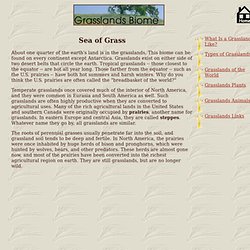

Grassland Animal Printouts. Grassland Biome. KDE Santa Barbara. Location | Weather | Plants | Animals | People | Links LOCATION: The name for this biome, temperate grasslands, is a great description for what it is like here.

The most important plants in this biome are grasses! Temperate grasslands have some of the darkest, richest soils in the world (not in wealth, but in nutrients). People who live in grassland regions often use these soils for farming. WEATHER: Temperatures in this biome vary greatly between summer and winter. PLANTS: Grasses dominate temperate grasslands. ANIMALS: All grasslands share a lack of shelter from predators, and an abundance. Grasslands Biome. Grassland biomes are large, rolling terrains of grasses, flowers and herbs.

Latitude, soil and local climates for the most part determine what kinds of plants grow in a particular grassland. A grassland is a region where the average annual precipitation is great enough to support grasses, and in some areas a few trees. The precipitation is so eratic that drought and fire prevent large forests from growing. Grasses can survive fires because they grow from the bottom instead of the top. Their stems can grow again after being burned off. When the settlers of the United States moved westward, they found that the grasslands, or prairies as they called them, were more than just dry, flat areas. There are two different types of grasslands; tall-grass, which are humid and very wet, and short-grass, which are dry, with hotter summers and colder winters than the tall-grass prairie. Grasslands. Modern agriculture does make some nods to these problems.

Crop rotation, where one crop is grown in a field one year and another crop the next, does much to combat the worst problems of pest buildup and soil nutrient exhaustion in fields. In many cases, corn is rotated with soybeans; the latter are legumes which harbor Rhizobium, an endosymbiotic bacterium which converts atmospheric nitrogen into a form that plants can use to make proteins. In this way, planting soybeans (or alfalfa) may increase the nitrogen content of the soil and reduce the need for nitrogen-based fertilizers. In any event, agricultural systems displace natural communities; given the world's need for food to feed the human population (and we're now raising corn to convert into ethanol to fuel our cars!)
This is not due to change anytime soon. As an aside, it should be pointed out that not all of our agriculture is for food. Today, a top area of research is prairie restoration. Grasslands Biome. About one quarter of the earth's land is in the grasslands.

This biome can be found on every continent except Antarctica. Grasslands exist on either side of two desert belts that circle the earth. Tropical grasslands -- those closest to the equator -- are hot all year long. Those farther from the equator -- such as the U.S. prairies -- have both hot summers and harsh winters. Why do you think the U.S. prairies are often called the "breadbasket of the world? " Temperate grasslands once covered much of the interior of North America, and they were common in Eurasia and South America as well. The roots of perennial grasses usually penetrate far into the soil, and grassland soil tends to be deep and fertile. The grassland biome. Online exhibits : The world's biomes The grassland biome Grasslands are characterized as lands dominated by grasses rather than large shrubs or trees.

In the Miocene and Pliocene Epochs, which spanned a period of about 25 million years, mountains rose in western North America and created a continental climate favorable to grasslands. Ancient forests declined and grasslands became widespread. Following the Pleistocene Ice Ages, grasslands expanded in range as hotter and drier climates prevailed worldwide.
Savanna Savanna is grassland with scattered individual trees. The soil of the savanna is porous, with rapid drainage of water. Savanna has both a dry and a rainy season. Other animals (which do not all occur in the same savanna) include giraffes, zebras, buffaloes, kangaroos, mice, moles, gophers, ground squirrels, snakes, worms, termites, beetles, lions, leopards, hyenas, and elephants. Temperate grassland.